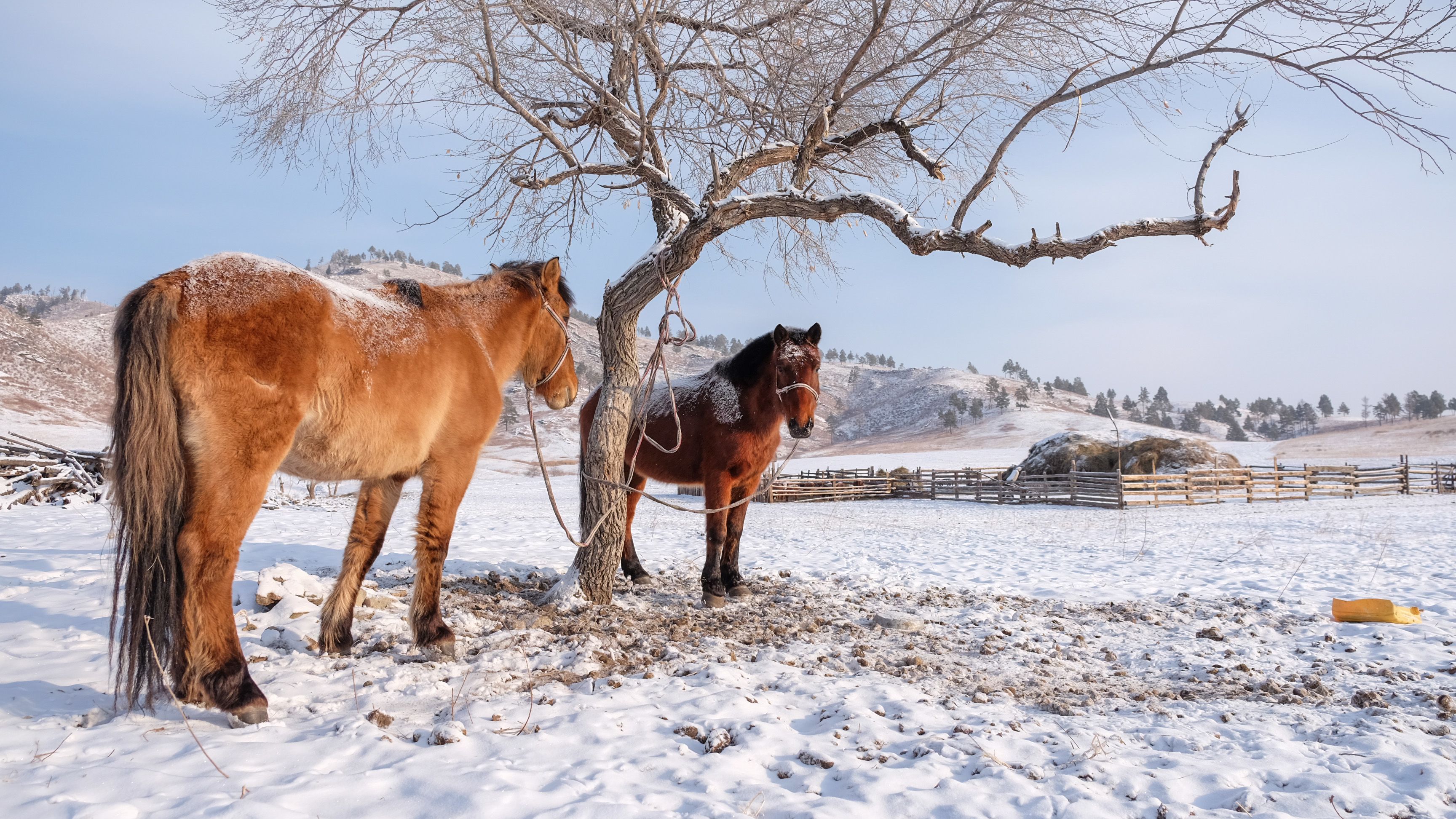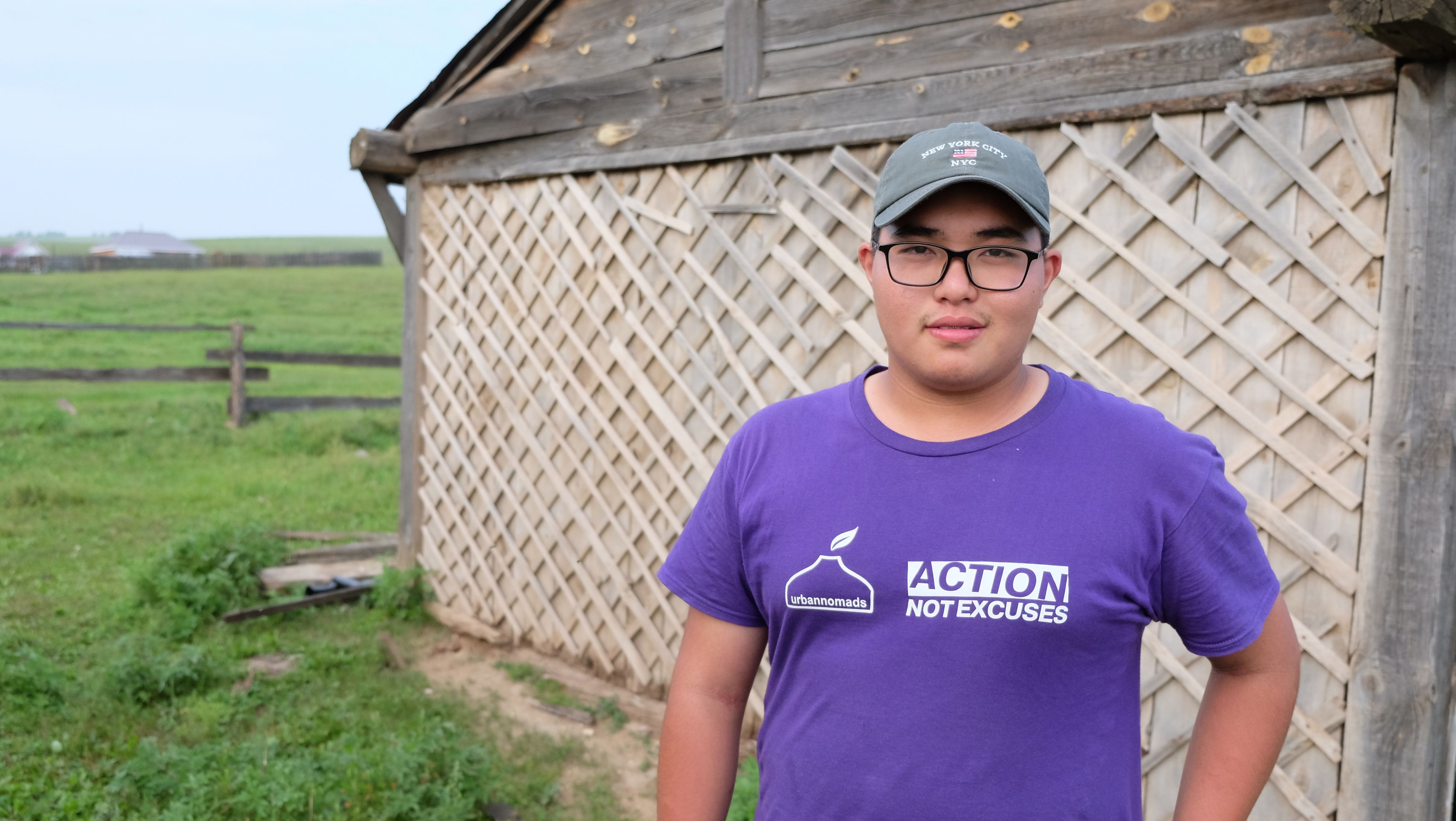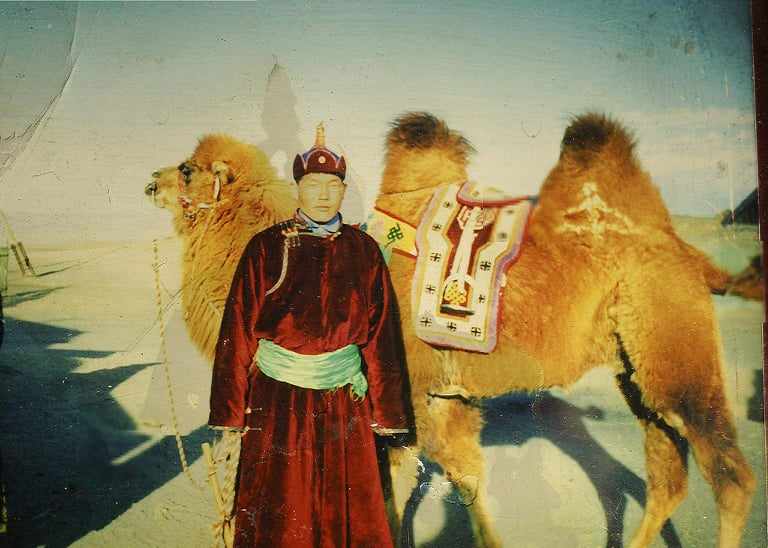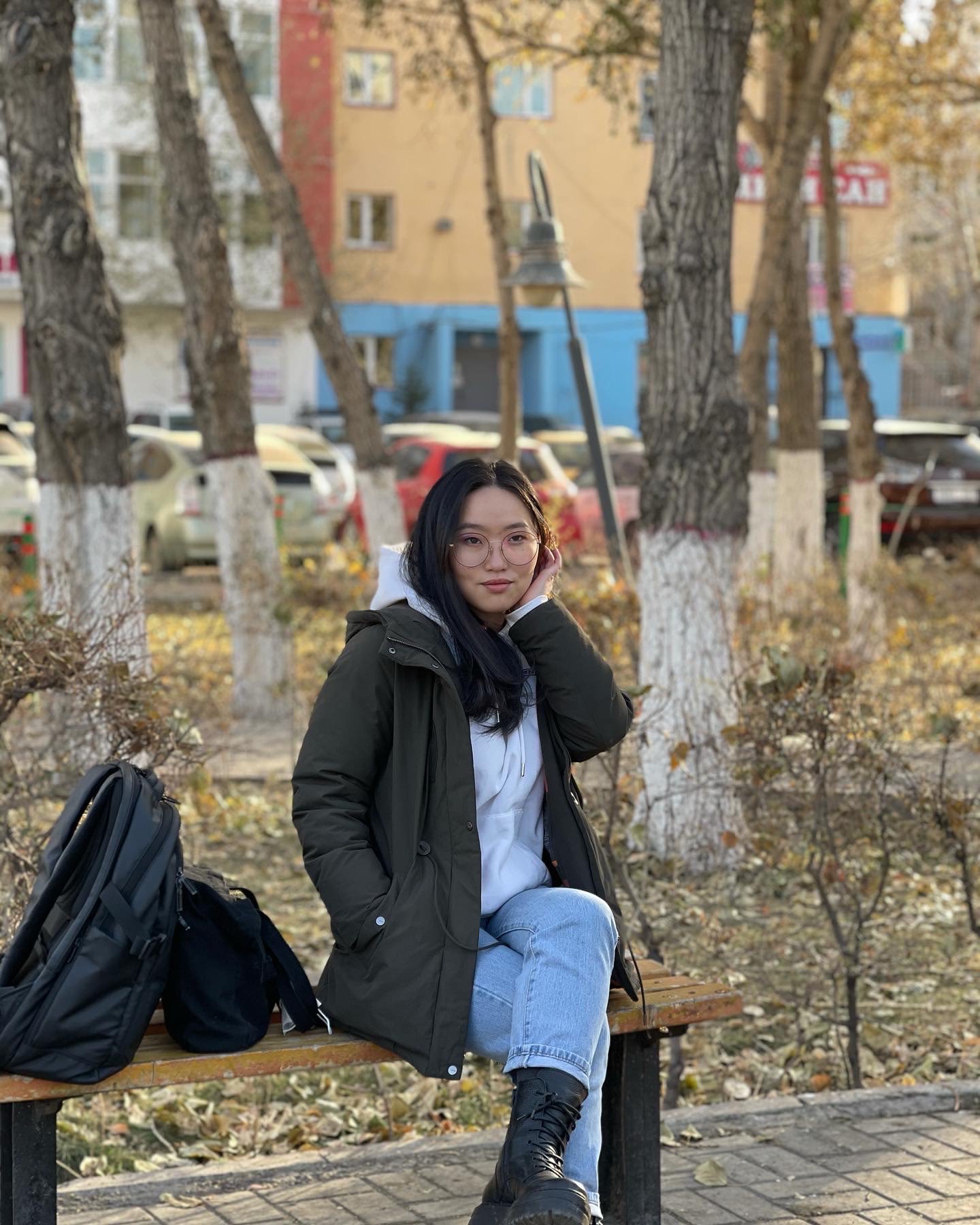NextGen Mongolia

Five young people from Mongolia share their stories of the climate emergency






Khash-Erdene and Anudari Gunbaatar
Khash-Erdene and Anudari Gunbaatar

Sainsanaa Tselmuun
Sainsanaa Tselmuun

Maral Jargalsaikhan
Maral Jargalsaikhan

Narangerel Mendsanaa
Narangerel Mendsanaa
Anudari from Ulaanbaatar speaks to traditional herders who fear their cultural heritage could soon be lost.
IN traditional dress, nomadic herder Zorigoo Delger stands proudly next to one of his camels in Mongolia’s wilderness.
His family have been herders for centuries, but now the nomad way of life, of huge symbolic significance to the landlocked country, is at risk.
Climate driven extreme weather events, such as sandstorms and desertification, make life very difficult for the herders.
In March 2021, Mongolia experienced its worst sandstorm in a decade, which started in the Gobi Desert and reached most of northern China and even western parts of South Korea.
Zorigoo, a 45 year-old herder from Umnugobi, a province in Mongolia’s Gobi Desert, says: “Everything went dark, it was like the sky and the earth had collapsed together and I could barely see.”

Zorigoo as a young man
Zorigoo as a young man
It is common for herds to go missing during such storms, but Zorigoo was more worried about his fellow herders.
“It’s very dangerous for herders to be out in the open during big storms,” he adds.
During big storms where airborne dust and sand covers the sky and blocks the sunlight, sand particles fly at such a high speed you can barely open your eyes.
The best the herders can do is huddle in the middle of their animals and ride it out.
The storm, which was the worst in over a decade, claimed the lives of 10 herders and lasted for one day and one night in the region of Khongoriin Gol, where Zorigoo lives.

Emergency workers rescue a woman trapped in her home after the sandstorm
Emergency workers rescue a woman trapped in her home after the sandstorm
“The electricity got cut off because of the storm and we couldn’t leave our home because the wind was so strong and it was so dark,” Zorigoo says.
“I couldn’t see even 10 steps ahead of me. When the storm cleared, there was sand and dust everywhere.”
Sandstorm, which is exacerbated by desertification, is one of the biggest challenges Mongolia is facing as a result of its unique climate and human activity.
Mongolia, a landlocked country nestled between Russia and China, covering over 1.5 million square km with only just about 3.3 millions of population, is one of the driest countries in the world.
Because of its semi-arid and dry climate, Mongolia has been hit quite hard by climate change.
The country has experienced a temperature increase of 2.24C between 1950 - 2015, which is more than two times the global average, and the average annual precipitation reported dropped by 7 per cent.
Predictions the average warming could exceed 5C by the end of the century in Mongolia paints a very uncertain future for its people.
Amid the further drying of Gobi and frequent sandstorms, Zorigoo is concerned about drought and the subsequent pasture loss.
2020 and 2021 had seen exceptionally dry summers for Mongolia, to the point there were wildfires everywhere and the vast Mongolian plateau had barely any green.
Traditional Mongolian herders like Zorigoo are susceptible to any kind of climate change - weather fluctuations, natural disasters such as drought, sand and snowstorms and extremely cold winters.
All of these issues are affecting native plants and crops.
Zorigoo says: “Some plants that used to grow in the wild have not been seen in the last decade, and the sand has been expanding so much that the local springs and oases have dried up, and herders have even harder time finding decent pasture land for their herds.”
He has also noticed the change in the seasonal cycle, which is driving herding families into the capital city.
“The rain comes as late as late July and August, which leaves too little green and too little time for the herds to fatten up before winter comes.
“Herders don’t want their children to follow their path anymore, traditional herders like myself are becoming fewer and fewer,” says Zorigoo.
Zorigoo has observed the weather becoming hotter and drier in the last two decades.
Some semi-nomadic herder families who would spend the summer with Zorigoo have had to move as far as 500km to find decent pasture for their livestock before the harsh winter came.
If desertification continues to expand and the intensity and frequency of climate phenomena increases, which according to future climate projections it will, Gobi herders would have to move even further.
The migration and concentration of herders creates an issue of overgrazing, which contributes to the process of desertification.
Zorigoo worries that the overgrazing by herders with 1,000-2,000 livestock would leave no space and no nourishment for his herd.
Another herder, Batpurev Lkhagvasuren, 45, of Selenge soum of Bulgan province, says deforestation is another huge problem.
Speaking at their family’s winter home near Ikh Khailantai forest, which belonged to his father, he says: “My wife Khandaa is a local ranger who looks after the forest and monitors logging. Our village’s main source of income is logging and it is becoming more and more intense.
“Until the 90s, the forest was much denser, thus the morning fog in summer used to sit in the valley until 11am.
“Deforestation and overgrazing has decreased plant diversity here, therefore the quality of forage is becoming poor.
“The dry summer of 2019 didn’t let us harvest much forage and the two-day storm at the end of winter took down many of our villagers’ cattle and calves.
“Such loss leads herders to seek another source of income, which is logging. This vicious cycle has to be broken. I am going to try to reintroduce some plants that we call Gogod and Hunheel which used to grow here.”
The herders of Mongolia are living through climate change and have experienced the challenges it has brought.
And they are trying to mitigate it by planting trees where and when they can.
But they also say there is a distinct lack of sense of urgency at both the policy and grassroots level.
To protect Mongolia’s nomadic herders, drastic action must be taken before their heritage is lost forever.





Life in one of the world's most polluted cities
Ulaanbaatar

By Narangerel Mendsanaa, 18, & Maral Jargalsaikhan, 17, in Ulaanbaatar
The sky could be the brightest blue, but in the winter months no one in Mongolia’s capital city would be able to tell because of the lingering smog.
Ulaanbaatar is one of the most polluted capital cities in the world and also densely populated - it’s home to half of Mongolia’s three million population.
In winter, temperatures in the world’s coldest capital can plummet to minus 30 and the only way for many people to stay warm is to burn raw coal.
At its worst, pollution levels reach 687 micrograms per cubic metre — 27 times the level WHO recommends as safe.
In 2018, UNICEF declared an air pollution crisis in the country.
The report warned: “Air pollution has become a child health crisis in Ulaanbaatar.
"The risks include but are not limited to stillbirth, preterm birth, lower birth weight, pneumonia, bronchitis, asthma and death.
"There is also emerging evidence that air pollution is linked to impaired cognitive development, already occurring during pregnancy and a child’s early years. Furthermore, these children will be at higher risk from chronic health problems later in life.”
In addition to thousands of homes relying on coal for heating, power plants also burn coal, pumping out carbon dioxide near to where some of the poorer communities reside.
Young people we spoke to told of the impact the suffocating pollution was having on their health.
“When walking outside without a mask, the throat stings and coughs,” 15-year-old Egshglen says.
“When I open the window to let the air in, I smell smoke, and I'm stressed because I can't get enough fresh air.
“Without a mask, you can't get fresh air. This is probably due to the fact that the factories are being built too close to the Ger districts, the fuel used and the number of cars.”
Anujin G, a 16-year-old student, also wears a mask whenever she leaves the house in the winter because the smog is so bad.

Anujin
Anujin
“We first started wearing a smoke mask in 2017, and wearing it for long hours caused shortness of breath, headaches, and stress,” she says.
“To protect themselves against air pollution, my family inspects their cars and uses filters every year. However, the effects are still there, such as skin rashes, headaches, and chest pains. In the past, white clothes and curtains were soot.”
Nomin, 16, adds: “We have many young children in our home, so we use as many healthy things as possible, wear masks, and have air conditioning in our homes.
"There is a lot of smoke, and when you leave home in the morning, you have a sore throat and nausea, and when you go out in the evening, you feel like you are walking in a ruined city.

Nomin
Nomin
“Lately, air quality has been deteriorating and the effects have been so great that people can't even sleep with their windows open, and their skin dries out quickly.”
Things got so bad that the Mongolian government introduced a ban on burning raw coal, which is largely relied upon by the Ger communities - people who live in traditional yurts on the outskirts of the city.
Instead, the government introduced refined coal briquettes which officials say last longer and emit fewer fumes than raw coal, but they are more expensive.
Poorer families have since resorted to burning other fuels to stay warm.
The air quality has improved since the ban, but young people we spoke to still reported struggles with breathing.
Anar, 16, says: “Because of the poor quality of the air we breathe, we have increased headaches, nasal congestion, irritability, stress, and psychological instability.”
The outline of Ulaanbaatar used to be visible from a few miles away, but sometimes it is shrouded by black smoke.
“When we go to a skiing place which is about 5kms far away from Ulaanbaatar, the smoke and pollution above it used to look greyish and the city was visible under the smoke,” 15-year-old Odjargal says.
“But this year, the view from the skiing place was just completely blackened and we thought the city was gone for a moment.”

Odjargal
Odjargal
Khash-Erdene, a 20-year-old student, says the poor air quality has irritated her skin and caused acne.
“I get a lot of acne on my skin, which makes me live an angry life,” she says.
Ulaanbaatar lies at the bottom of a valley, which means the pollutants in the air get trapped and remain near the ground.
This, in addition to a growing population because of the number of people moving from the country to the city, means it’s a hotbed for air pollution.
But young people of Ulaanbaatar are coming together to do what they can to tackle the poor air quality.
They’re making a positive contribution by ditching cars and using public transport and most importantly, planting trees.
Eco-volunteering group Myclub, founded in 2009, has so far planted about 1.4 million trees across the countryside and in the capital.

Young volunteers, usually between 14-18 give up their Saturdays between April - October every year to plant trees.
Their vital work includes cleaning tree seedling fields, preparing them, planting them and watering the trees planted the previous year if there is not enough precipitation.
MyClub also gives crucial ecology knowledge to many youths, fulfilling its main goal of educating more young people to fight the climate crisis.
This alone will not solve Ulaanbaatar’s air pollution problem, but the programme, along with the government’s One Billion Trees by 2030 scheme, is a step in the right direction.
And one day, young people of the city hope that when they look up during the winter months, they will not see smog but a clear blue sky.


Fixing Mongolia's urban migration problem

By Khash-Erdene, 20, Bulgan province
In Mongolia, there is a high rate of migration from rural to urban areas.
I am from a town in Bulgan province.
Our hospitals are inadequate and have little equipment, so our people have to go to bigger cities to get diagnosed and treated for serious illnesses.
Recently during Covid-19, there were not enough hospital rooms and only one doctor and one nurse who had to be in isolation with all their patients for seven days in a row.
There are no dentists, ophthalmologists, and visceral doctors in the isolated provinces, so people have to go to big cities to be diagnosed and treated for serious diseases.
Our local schools do not provide a good education because rural teachers lag behind their peers in cities.
Since there are not enough teachers, one will teach at least two different subjects.
Differences between the urban and rural quality of education are often reflected in foreign language levels.
These are just some of the factors pushing more and more families and young people to migrate to urban cities.
On a tree-planting mission with Raleigh Mongolia in January, I met 46-year-old Enkhbaatar Nyamdorj, a herder from Selenge soum, Bulgan aimag to get his take on why young people are moving away from the countryside.
In the last 30 years since the fall of the old regime in Mongolia, environmental and economic changes have brought many of such unfamiliar issues to his village.
He explained: "Recent natural changes, such as slow grass growth in spring, less rain in summer and late frosting in Autumn, are reducing pasture yields and the overgrazing is aggravating it further.
“In general, the climate is becoming unfamiliar to us, so we need investment for new skills and equipment.
“In the past, nomadic pastoralists only needed livestock and pastures, but now we need equipment for growing and harvesting fodder.”
After the fall of the Soviet Union, Mongolia transitioned from communist rule to a democratic capitalist state in the 1990s.
This had a knock-on effect as communities adjusted to a new regime.
“During the socialist era, the Selenge region was agricultural and my parents were converted from herders to farmers,” Enkhbaatar says.

Enkhbaatar
Enkhbaatar
“After the transition in the 1990’s all socialist structures were disassembled thus our villages economies crumbled in between traditional nomadic animal husbandry and post-soviet style farming.
“These changes have confused our lives, especially our children.
“Today, young people in our villages move to major cities in search of work, and less than 20 percent of young people stay in their villages to maintain their traditional lifestyles.
“They do not imagine their future in the village. There is a shortage of working-age professionals in the village, for example, current doctors and veterinarians are all pensioners who have to continue working despite their retirements.
“Our community is now looking for ways to revitalise the village.”
One of those ways involves a tree planting programme with Raleigh Mongolia, a civil society organisation run by Mongolian young people in association with Raleigh International.
The programme supports the local Forest Community of Selenge-Buren soum of Bulgan province in establishing their own tree nursery, which not only addresses the issue of deforestation, but also creates sustainable green business for the local community.

Bat-Ulzii
Bat-Ulzii
Another herder involved in the forestry programme, Bat-Ulzii, says: “To support nature, our forest group has planted tree seedlings a lot since 2015, reaching up to 10,000 seedlings per year and planted in several hectares of land.
“The cycle begins with picking the tree seeds from the forest in the winter with care, nurturing them in nursery soil until they become seedlings and planting them in the areas where needed.
“Time and resources are required for this nature-based solution. Due to the financial hardships our forest group had to stop its tree planting operation in the last few years.
“However, with support from the Raleigh Mongolia initiative, we are happy to restart the tree planting and eager to contribute to the billion tree campaign by the President of Mongolia.”



Tree planting solutions

To tackle desertification and deforestation, young volunteers with Raleigh Mongolia ventured into the countryside to collect seeds to plant in the spring.
The volunteers form the group Urban Nomads, which is an Action Not Excuses campaign led by young people in Mongolia to decrease migration flow from Mongolia’s countryside to the cities.
High rates of migration result in rising air pollution and overpopulation in Mongolia’s capital, as well as the underpopulation of young people in rural areas.
Through Urban Nomads, Mongolian youth are inspiring young people to recognise the potential of the resources which they can access in their own rural hometowns, to lower migration and support the wider environment in Mongolia.
The group braved sub-zero temperatures to collect pine tree seeds, gathering up an impressive 30kg of pine cones, which will be planted in spring.
The programme supports the local Forest Community of Selenge-Buren soum of Bulgan province in establishing their own tree nursery, which not only addresses the issue of deforestation, but also creates sustainable green business for the local community.
All the trees planted support the Mongolian government’s nationwide tree planting campaign of One Billion Trees by 2030.


With special thanks to...
Nyamsuren Geserbadam of Raleigh Mongolia and Jamie Baird of Raleigh International.
The European Journalism Centre

Project lead - Rhian Lubin
Assisted by Helen Packer

